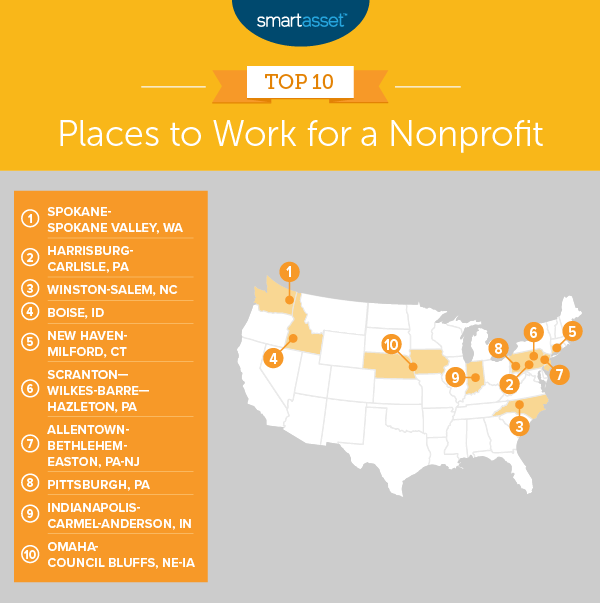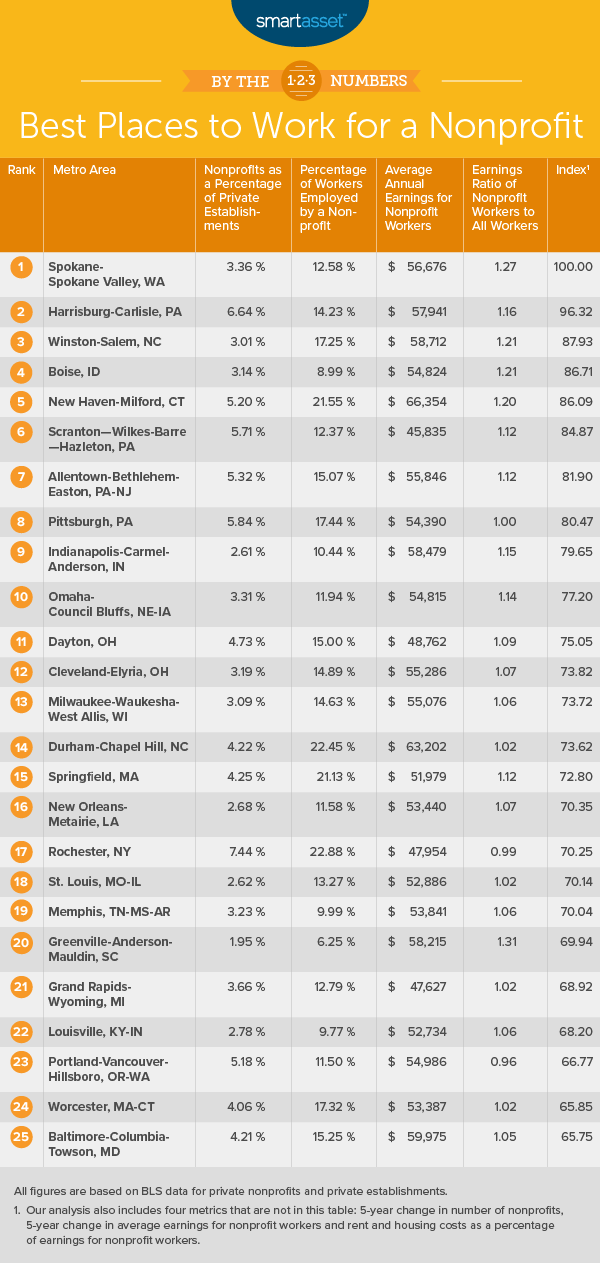
According to a recent report from the National Council of Nonprofits, U.S. nonprofits employ more than 10% of the total private workforce in the U.S., a higher percentage than in many other industries, including construction, transportation and finance. All told, of the 122 million workers employed by private establishments in America in 2017, almost 12.5 million worked for 501(c)(3) nonprofit establishments, according to the Bureau of Labor Statistics (BLS). The varying health of this sector in different areas may affect workers’ decisions on where to rent or take out a mortgage.
Given the large percentage of the private U.S. workforce employed by nonprofits, SmartAsset uncovered some of the best places to work for these mission-driven organization. In this study, we examined data for 100 metro areas across eight metrics, looking at the current environment for nonprofit workers and changes over the five-year period from 2013 through 2017. For more information on our data sources and how we created the final rankings, check out our Data and Methodology section below.
Key Findings
- Pennsylvania is well-suited for nonprofit workers. Four of the metro areas in our top 10 are in the Keystone State. The metro areas include Harrisburg-Carlisle, Scranton–Wilkes-Barre–Hazleton, Allentown-Bethlehem-Easton and Pittsburgh, ranking second, sixth, seventh and eighth, respectively.
- The number of nonprofits is increasing in most areas. In all but five of the 100 metro areas in our study, the number of nonprofits increased between 2013 and 2017. In fact, in 30 metro areas, the number of nonprofits increased by 15% or more over that five-year period.

1. Spokane-Spokane Valley, WA
The Spokane, Washington metro area ranks as the top place for nonprofit workers primarily because of increases in the number of nonprofits and average wages for nonprofit workers in the five-year period from 2013 through 2017. There were 28.67% more nonprofits in the Spokane metro area in 2017 than there were in 2013, and average wages for nonprofit workers rose by 18.34% over the same time period. Relative to all 100 metro areas for which we considered data, the Spokane metro area ranks 10th and third on those two metrics, respectively.
2. Harrisburg-Carlisle, PA
In 2017, about 6.64% of all private establishments in the Harrisburg, Pennsylvania metro area were nonprofits, the fifth-highest percentage for this metric across all metro areas we studied. Moreover, a high percentage of workers, 14.23%, were employed by a nonprofit. The high percentages of nonprofit establishments and nonprofit workers in the Harrisburg metro area suggests that there are many opportunities for residents to work for an impact-driven organization.
3. Winston-Salem, NC
Average earnings for nonprofit workers in conjunction with low housing costs put Winston-Salem, North Carolina in the No. 3 spot on our list. In 2017, the average annual earnings for a nonprofit worker in Winston-Salem was $58,712, the 15th-highest amount of all 100 metro areas for which we considered data. With a median monthly rent of $730 and median monthly housing costs of $771, rent and housing costs represent 14.92% and 15.76% of the average earnings for a nonprofit worker, respectively. These are the lowest rates for both metrics in our study.
4. Boise, ID
Though only 8.99% of workers in Boise, Idaho are employed by a nonprofit, the five-year change in average earnings for nonprofit workers may entice more nonprofit workers to move there. From 2013 to 2017, average earnings for nonprofit workers increased by 17.58%, the sixth-highest rate for this metric overall. Additionally, the number of nonprofits in Boise increased by 25.14%, the 11th-highest rate for this metric overall and the second-largest increase of any area in our top 10.
5. New Haven-Milford, CT
Approximately 21.55% of working residents in New Haven-Milford, Connecticut work for 501(c)(3) establishments, the highest percentage for this metric of any area in our top 10 and fourth-highest overall. The average annual earnings for a nonprofit worker in New Haven-Milford were $66,354 in 2017, the highest amount in our top 10 and fifth-highest overall. Those looking to stretch their paycheck further in New Haven are in luck: it ranks third in our study of the most undervalued cities in America.
6. Scranton—Wilkes-Barre—Hazleton, PA
The Scranton, Pennsylvania metro area ranks in the top third of all metro areas for all but one of the eight metrics. It performs particularly well when it comes to the change in average earnings for nonprofit workers. In the five-year period from 2013 through 2017, average earnings for nonprofit workers in the Scranton area rose by 19.91%, the second-largest increase of any area in our study, following only Baton Rouge, Louisiana.
7. Allentown-Bethlehem-Easton, PA
The number of nonprofits in the Allentown, Pennsylvania metro area has remained relatively flat over the past five years, increasing by only 4.73% and ranking 84th of the 100 total areas that we considered. Despite this, Allentown-Bethlehem-Easton still has the eighth-highest percentage of nonprofits compared to all private establishments, 5.32%, suggesting that the environment for nonprofits and nonprofit workers remains strong. The five-year change in average earnings for nonprofit workers reinforces this. Between 2013 and 2017, wages increased by 16.72%, the ninth-highest percentage increase of any metro area.
8. Pittsburgh, PA
Like Harrisburg-Carlisle, there are high percentages of nonprofits and nonprofit workers in Pittsburgh, Pennsylvania, which comes in eighth overall. BLS data from 2017 shows that 5.84% of private establishments were nonprofits, and 17.44% of workers were employed by a nonprofit. Additionally, rent and housing costs as a percentage of average earnings for nonprofit workers are relatively low, each hovering around 18%.
9. Indianapolis-Carmel-Anderson, IN
Jobs for nonprofit workers in the Indianapolis, Indiana metro area may be more difficult to find than in other metro areas in our top 10, but for nonprofit workers who are employed, the Indianapolis metro scores well on the earnings metrics we considered. In particular, nonprofit wages increased by 14.44% in the five-year period from 2013 through 2017, and average annual earnings for nonprofit workers there were $58,479, the third-highest of any metro area in our top 10 and 17th-highest overall.
10. Omaha-Council Bluffs, NE-IA
Omaha-Council Bluffs, Nebraska-Iowa rounds out our list of the top 10 places to work for a nonprofit. It has had the fifth-largest increase in average annual earnings for nonprofit workers of any metro area, at 17.70% in the five-year period from 2013 through 2017. Despite this increase, nonprofit workers may be better off renting than buying in the Omaha-Council Bluffs metro area as median annual housing costs are much higher than median annual rent. Annual rent is about 3.5% cheaper than annual homeownership costs for the average nonprofit worker in the Omaha metro area.

Data and Methodology
To find the best places to work for a non-profit, we analyzed data for 100 metro areas across eight metrics. They include:
- Nonprofits as a percentage of all establishments. This compares private nonprofits to private establishments. Data is from the Bureau of Labor Statistics and is for 2017.
- Percentage of workers working for a nonprofit. Data is from the Bureau of Labor Statistics and is for 2017.
- Average annual earnings for nonprofit workers. Data is from the Bureau of Labor Statistics and is for 2017.
- Ratio of earnings for nonprofit workers to earnings for all workers. Data is from the Bureau of Labor Statistics and is for 2017.
- Five-year change in the number of nonprofits. This is the percentage change in the number of nonprofits from 2013 through 2017. Data comes from the Bureau of Labor Statistics.
- Five-year change in average earnings for nonprofit workers. This is the percentage change in the number of nonprofit workers from 2013 through 2017. Data comes from the Bureau of Labor Statistics.
- Rent as a percentage of the average earnings for nonprofit workers. Data comes from the U.S. Census Bureau’s 1-year American Community Survey and Bureau of Labor Statistics. Both data points are for 2017.
- Housing costs as percentage of the average earnings for nonprofit workers. Data comes from the U.S. Census Bureau’s 1-year American Community Survey and Bureau of Labor Statistics. Both data points are for 2017.
For all of the above metrics, we considered only private 501(c)(3) nonprofit establishments per the Bureau of Labor Statistics’ reporting on the nonprofit sector.
To create our final list, we ranked each metro area in every metric. We then found each metro area’s average ranking, giving each metric an equal weighting with the exception of rent and housing costs as a percentage of the average earnings for nonprofit workers, each of which received a half weight. We used the average ranking to determine a final score. The metro area with the highest average ranking received a score of 100 and the metro area with the lowest received a score of 0.
Tips for Managing Your Savings
- Invest early. An early retirement requires early planning. No matter what your goals are, an advisor can help you get the most of your money. Finding the right financial advisor that fits your needs doesn’t have to be hard. SmartAsset’s free tool matches you with financial advisors in your area in just five minutes. If you’re ready to be matched with local advisors that will help you achieve your financial goals, get started now.
- Buy or rent? – When you’re moving to a new city, you need to decide if you are going to rent or buy. If you are coming to a city and plan to stay for the long haul, buying may be the better option for you. On the other hand, if your stop in a new city will be a short one, you’ll likely want to rent.
Questions about our study? Contact us at press@smartasset.com
Photo credit: ©iStock.com/SDI Productions